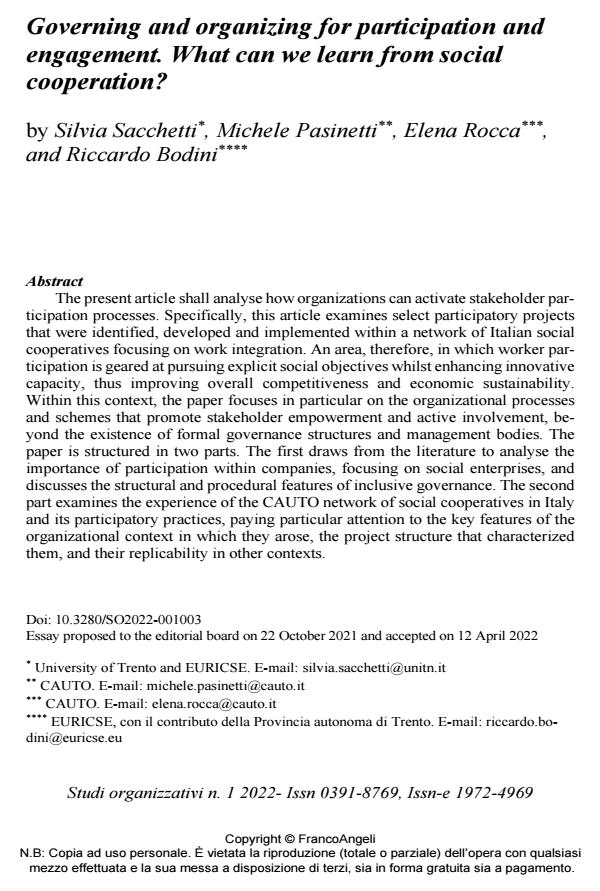Governing and organizing for participation and engagement. What can we learn from social cooperation?
Titolo Rivista STUDI ORGANIZZATIVI
Autori/Curatori Silvia Sacchetti, Michele Pasinetti, Elena Rocca, Riccardo Bodini
Anno di pubblicazione 2022 Fascicolo 2022/1
Lingua Inglese Numero pagine 33 P. 50-82 Dimensione file 339 KB
DOI 10.3280/SO2022-001003
Il DOI è il codice a barre della proprietà intellettuale: per saperne di più
clicca qui
Qui sotto puoi vedere in anteprima la prima pagina di questo articolo.
Se questo articolo ti interessa, lo puoi acquistare (e scaricare in formato pdf) seguendo le facili indicazioni per acquistare il download credit. Acquista Download Credits per scaricare questo Articolo in formato PDF

FrancoAngeli è membro della Publishers International Linking Association, Inc (PILA)associazione indipendente e non profit per facilitare (attraverso i servizi tecnologici implementati da CrossRef.org) l’accesso degli studiosi ai contenuti digitali nelle pubblicazioni professionali e scientifiche
The present article shall analyse how organizations can activate stakeholder participation processes. Specifically, this article examines select participatory projects that were identified, developed and implemented within a network of Italian social cooperatives focusing on work integration. An area, therefore, in which worker participation is geared at pursuing explicit social objectives whilst enhancing innovative capacity, thus improving overall competitiveness and economic sustainability. Within this context, the paper focuses in particular on the organizational processes and schemes that promote stakeholder empowerment and active involvement, beyond the existence of formal governance structures and management bodies. The paper is structured in two parts. The first draws from the literature to analyse the importance of participation within companies, focusing on social enterprises, and discusses the structural and procedural features of inclusive governance. The second part examines the experience of the CAUTO network of social cooperatives in Italy and its participatory practices, paying particular attention to the key features of the organizational context in which they arose, the project structure that characterized them, and their replicability in other contexts.
Questo articolo prende in esame i modi in cui le organizzazioni possono attiva-re processi partecipativi da parte dei propri stakeholder. In particolare, l’articolo analizza alcuni progetti di partecipazione identificati, sviluppati e implementati all’interno di una rete di cooperative sociali italiane. Un ambito, quindi, in cui la partecipazione dei lavoratori è orientata al perseguimento di espliciti obiettivi so-ciali e nel contempo al miglioramento delle capacità di innovazione, aumentando quindi la competitività e la sostenibilità economica dell’impresa. In questo contesto, il paper si concentra in particolare sui processi organizzativi che promuovono l’empowerment e il coinvolgimento attivo dei portatori di interesse, al di là della presenza di strutture formali di governo e gestione partecipata dell’organizzazione. L’articolo è strutturato in due parti. La prima si basa sulla letteratura per analizzare l’importanza della partecipazione nelle imprese, concentrandosi sulle imprese sociali e prendendo in esame le caratteristiche strutturali e procedurali della governance inclusiva. La seconda parte esamina l’esperienza della rete di cooperative sociali italiane CAUTO e le pratiche partecipative che ha messo in atto, pre-stando particolare attenzione alle caratteristiche chiave del contesto organizzativo in cui sono nate, alla struttura progettuale che le caratterizza, e alla loro replicabilità in altri contesti.
Parole chiave:Governance inclusiva, progetti partecipativi, coinvolgimento degli stakeholder, cooperazione sociale, impresa sociale, gestione di impresa, Italia.
Silvia Sacchetti, Michele Pasinetti, Elena Rocca, Riccardo Bodini, Governing and organizing for participation and engagement. What can we learn from social cooperation? in "STUDI ORGANIZZATIVI " 1/2022, pp 50-82, DOI: 10.3280/SO2022-001003